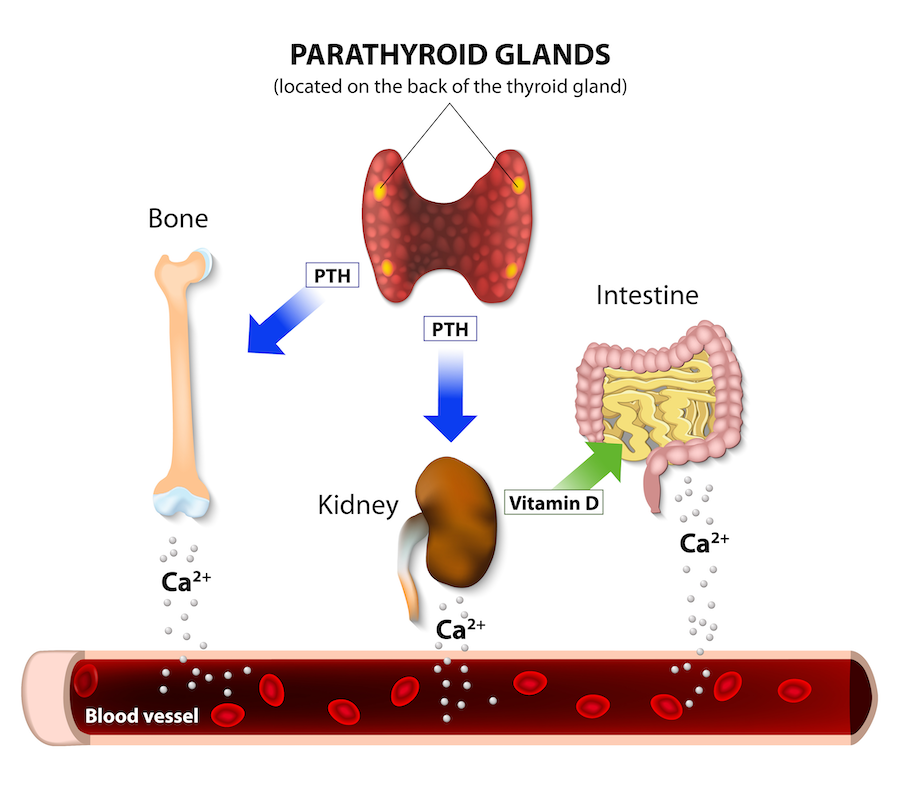Parathyroid Glands
The parathyroid glands are completely different in function from the thyroid gland, but named “parathyroid” because they are located close to the thyroid gland. Parathyroid glands make parathyroid hormone, which circulates in the blood and maintains a concentration of calcium in the blood.
parathyroid function
Parathyroid glands’ job is to detect a low blood calcium level and when this happens, produce parathyroid hormone. This parathyroid hormone is released into the blood and acts on the gut, kidneys, and bones to increase the blood calcium level. When the blood calcium has risen, the parathyroid glands slow or stop the production of parathyroid hormone. This feedback system is the normal mechanism for maintaining a normal calcium level in the blood.
Maintaining a normal range of calcium concentration in the blood is important. The body regulates calcium levels through an interplay of hormones, primarily parathyroid hormone (PTH), calcitonin, and vitamin D. When blood calcium levels dip too low, the parathyroid glands release PTH, stimulating the bones to release calcium and enhancing calcium absorption in the intestines and kidneys. PTH also stimulates the activation of vitamin D in the kidneys, which in turn facilitates the absorption of calcium from the intestines. Conversely, when calcium levels rise, parathyroid hormone production decreases and calcitonin is released by the thyroid gland, acting to inhibit the release of calcium from the bones and promoting calcium excretion by the kidneys. This intricate feedback mechanism ensures that serum calcium levels remain within the optimal range, essential for proper nerve function, muscle contraction, blood clotting, and bone health. Very low calcium levels may cause numbness or tingling, often felt in the fingertips or lips, muscle spasms, and even an irregular heartbeat rhythm. Since the body will take calcium from the bones to remedy a low blood calcium problem, long-standing low levels of calcium causes decreased bone strength and density, which can promote fractures.
parathyroid anatomy
The parathyroid glands are small endocrine glands located in the neck, usually situated behind the thyroid gland. Most individuals have four parathyroid glands, with two on each side of the thyroid. Despite their close proximity, the parathyroid glands are distinct from the thyroid and have their own unique anatomy. Each parathyroid gland is typically about the size of a grain of rice, measuring just a few millimeters in diameter.
An ectopic parathyroid gland is a gland away from its usual position behind thyroid gland. In some cases, these glands can be found in ectopic locations such as within the thyroid gland tissue, behind the esophagus, within the upper chest cavity, or in the carotid sheath, which is a wrap of connective tissue surrounding the carotid artery, internal jugular vein, and vagus nerve. This variable anatomy poses challenges in the diagnosis and management of parathyroid disorders. Experienced parathyroid surgeons have a thorough understanding of the ectopic parathyroid gland anatomy to facilitate precise localization during surgical interventions. Imaging techniques and advanced technologies have become invaluable to assist in identifying parathyroid glands.
From: Anatomy, Head and Neck, Parathyroid, Ectopic Glands
StatPearls [Internet].
Treasure Island (FL): StatPearls Publishing; 2023 Jan-.
Parathyroid disease
Disruption of normal parathyroid function is usually a matter of excess parathyroid hormone production (hyperparathyroidism) or insufficient parathyroid hormone production (hypoparathyroidism). Rarely, a parathyroid gland may develop a cyst, which does not usually influence parathyroid or calcium function, but can cause a diagnostic dilemma because they can grow into relatively large cysts of clear fluid diagnosable by testing this fluid for parathyroid hormone.
Hyperparathyroidism occurs in three types:
Primary hyperparathyroidism: The problem is that one or more parathyroid glands have developed into a tumor that produces too much parathyroid hormone and will not reduce parathyroid hormone output even when the blood calcium is high. A tumor of one or more parathyroid glands (parathyroid adenoma) is almost always benign, and but may be cancerous (parathyroid carcinoma) in about 1% of cases.
Secondary hyperparathyroidism: The problem is low blood calcium which the parathyroids try to correct by producing high amounts of parathyroid hormone. All of the parathyroids grow large due to their constant efforts to make enough parathyroid hormone to correct the problem. The causes for low calcium are varied, but most commonly, it is kidney disease. If the cause for low calcium is corrected, the parathyroids usually return to normal size and normal parathyroid hormone production.
Tertiary hyperparathyroidism: This is a less common situation in which a person has secondary hyperparathyroidism and then the cause for low calcium is corrected. This might be a kidney transplant, for example. But in a small subset of patients, the overactive parathyroid glands do not return to a normal status and instead, almost like a “habit,” continue to overproduce parathyroid hormone even after the blood calcium levels have normalized.
Get the most from your parathyroid appointment
Appointment time is valuable. Below are some suggestions to make the most of your appointment. This preparation will help you and your doctor maximize efficiency and accuracy, freeing up time for questions and answers.
This page








